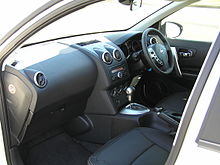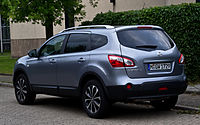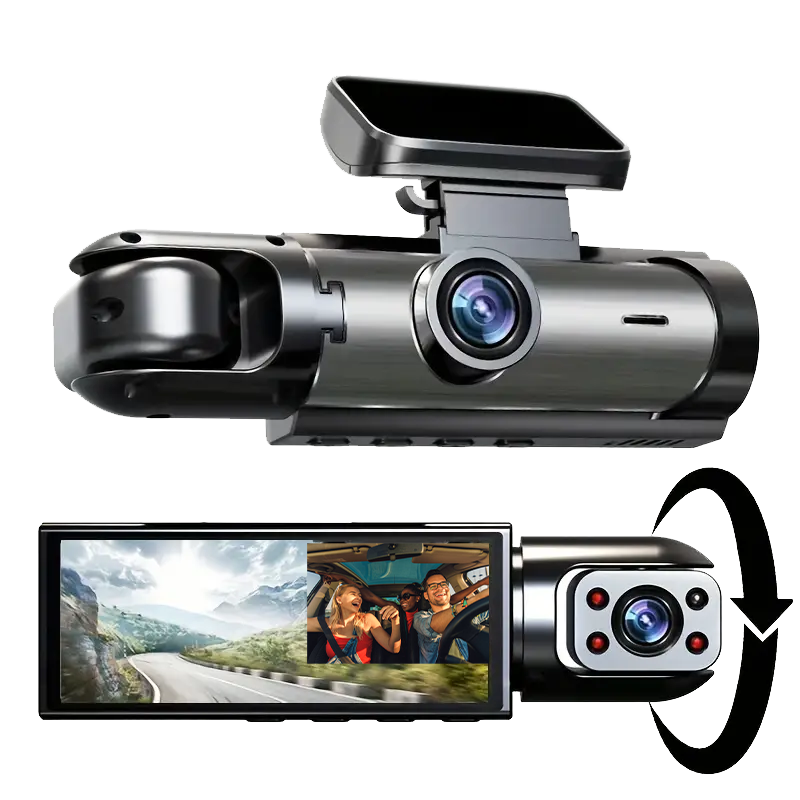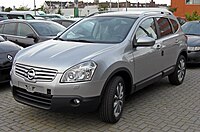
Nissan Qashqai First Generation 2006- 2013

| Nissan Qashqai | |
|---|---|
 |
|
| Overview | |
| Also called | Nissan Dualis (Japan and Australia) |
| Production | 2006–2013 |
| Assembly | Sunderland, Tyne and Wear, England (NMMUK) Kanda, Fukuoka, Japan |
| Body and chassis | |
| Body style | 5-door Crossover |
| Layout | Front-engine, front-wheel-drive or four-wheel-drive |
| Platform | Nissan C platform |
| Powertrain | |
| Engine | 1.6 L HR16DE I4 (petrol) 2.0 L MR20DE I4 (petrol) 1.5 L K9K I4 (diesel) 1.6 L R9M I4 (diesel) 2.0 L M9R I4 (diesel) |
| Transmission | 5-speed manual 6-speed manual 6-speed automatic CVT automatic |
| Dimensions | |
| Wheelbase | 2,630 mm (103.5 in) 2,760 mm (108.7 in) (+2 version) |
| Length | 4,315 mm (169.9 in) 4,535 mm (178.5 in) (+2 version) |
| Width | 1,785 mm (70.3 in) |
| Height | 1,605 mm (63.2 in) |
| Chronology | |
| Successor | Nissan Juke (Dualis, Japan) Nissan X-Trail (Qashqai+2) |
Nissan Dualis (Japan; pre-facelift)
Name
Nissan considered releasing the Chinese version as the CCUV (Compact Crossover Utility Vehicle). In Australia the Qashqai carries the name Dualis from the Japanese domestic market version because Nissan worried Qashqai could be pronounced "cash cow". The press has often used that pun to describe the sales success of the model.
Production and sales
The Nissan Qashqai Concept at the 2004 Geneva Motor Show.
The Qashqai has been built at Nissan's Nissan Motor Manufacturing UK (NMUK) Sunderland, Tyne and Wear plant since December 2006.
It is the first model to be styled by Nissan Design Europe in London, with engineering development led by Nissan Technical Centre Europe (NTCE) in Cranfield, Bedfordshire. First unveiled as a concept vehicle at the 2004 Geneva Motor Show, it was globally presented at the 2006 Paris Motor Show.
By December 2007, Nissan had sold approximately 100,000 Nissan Qashqais in Europe, including 17,554 in the United Kingdom, 15,376 in Russia, and 10,746 in Italy. Since its facelift in 2010, the Qashqai has sold over 200,000 annual units in Europe (excluding Russia) every year, and the first generation Qashqai has sold more than 1.24 million units in Europe during its 7.5 year production run.
The Qashqai is exported to the Middle East and additional overseas markets.
In order to increase production capacity in Nissan's plant in Sunderland within the United Kingdom, some models of the 2014 Qashqai will be produced in Nissan's Russian plant in Saint Petersburg.
Features

Interior
Built on an all-new platform, the Qashqai went on sale in February 2007, and Nissan targeted more than 100,000 sales per year. Nissan said the car would cater to those buyers who want a more dynamic design, but are not attracted to the large, aggressive nature of a sport utility vehicle. The car slots below the X-Trail in the Nissan range and partially replaces the conventional Primera, even though it took the production place of the smaller Almera. In terms of size, its 4,310 millimetres (169.7 in) length and 1,610 millimetres (63.4 in) height make it fall between compact MPVs, such as the SEAT Altea and Peugeot 5008; and compact SUVs like the Hyundai Tucson, Kia Sportage and Mitsubishi Outlander.
The top half of Qashqai has a sleek, dynamic form with a distinctive shoulder line which rises at the rear — a design cue similar to that of the Nissan Murano. The lower portion resembles an SUV due to large, pronounced wheel arches and a slightly elevated ground clearance. The Qashqai uses the same platform as the X-Trail (the vehicle upon which the Qashqai is based). Nissan regards the Qashqai as a rival to such cars as the Toyota RAV4 and the Honda CR-V and in 2007 it received a five star Euro NCAP safety rating — the best ever adult occupant score.
Five engine choices are available: a 114 PS (84 kW; 112 bhp) 1.6 L or a 141 PS (104 kW; 139 bhp) 2.0 L petrol, while the 106 PS (78 kW; 105 bhp) 1.5 L, 130 PS (96 kW; 128 bhp) 1.6 L and 150 PS (110 kW; 148 bhp) 2.0 L provide the diesel offerings.
Qashqai NJ10 (+2)
Production of a seven-passenger version of the Qashqai, named "Qashqai+2", began at NMUK in July 2008. Launched in October 2008, it is a larger variant of the standard model with the wheelbase extended by 135 mm. The overall length of the car is extended by 211 mm to allow for a third row of seats, and roof height is increased by 38 mm at the rear.
From the A-pillar back the car's chassis is unique, but trim and engine models remain the same as on the standard Qashqai.
The Qashqai+2 has been discontinued after the 2013 model year and replaced by the new version of the X-Trail with a seven-seat configuration.
Nissan Qashqai+2 (pre-facelift)
Nissan Qashqai+2 (pre-facelift)

Nissan Qashqai+2 (facelift)
2010 facelift

Facelift Nissan Dualis Ti

Facelift Nissan Dualis ST
On 4 December 2009, Nissan announced the Qashqai's next version, which went on sale in March 2010. The model's front end has been completely restyled while the rear now includes LED tail-lights. Modifications to the interior include a new instrument panel layout for the vehicle's drive computer, better soundproofing and minor storage additions. ESP is now standard across the range and two new exterior colours have been added. The launch of an eco-friendly Pure Drive variant has also been announced.
2011 engine update
A new 1.6 dCi engine replaces the previous 2.0 dCi. Peak power is down from 110 kW (148 bhp; 150 PS) to 95 kW (127 bhp; 129 PS), but there's the same 320 N·m (240 lb·ft) of torque, available at 1750 rpm, rather than 2000 rpm. Nissan hasn’t released full performance figures, but says the 1.6 dCi has a quicker 50–80 km/h (31–50 mph) acceleration figure than the 2.0 dCi.
Nissan has also added its Around View Monitor as standard equipment for 360 (Replaces N-tec) versions of the Qashqai and Qashqai +2. The system uses a set of external cameras to create a 360-degree "bird's-eye" view of the car to help with parking manoeuvres. The driver can also focus individually on front, rear or passenger cameras to look out for a particular obstacle.
Marketing
The Japanese Domestic Market (JDM) Dualis is offered in 2.0 G, 2.0 S, 2.0 G Four, and 2.0 S Four trim levels. All models are powered by 2.0-litre MR20DE engine matched to 6-speed Xtronic CVT.Japan
The Dualis was discontinued in Japan on 31 March 2014. After the Dualis was discontinued, the Juke is the only mini SUV from Nissan that is still produced and sold in Japan.
Middle East
In most Middle East markets, the Nissan Qashqai is offered in S, SE and LE, Standard on all trims is the 2.0L 106 kW (142 bhp) MR20DE engine with CVT.
North America
Until 2017 the Qashqai was not offered in North American markets. Instead, Nissan offered the Nissan Rogue. Although larger and appearing to be a completely different model it is based on the same basic platform as the Qashqai / Xtrail with some visual similarities. In Mexico, the X-Trail and Rogue are both sold and the Qashqai is about to be offered in the Mexican Market. In January 2017 Nissan announced the second generation Qashqai will be sold in the United States and Canada (called the "Rogue Sport" in the US).
New Zealand
Nissan New Zealand also uses the Qashqai name to distinguish the model from Dualis grey imports that were shipped from Japan before the official release. The New Zealand spec Qashqai is sourced from Sunderland having initially been sourced from Japan. The range currently (2016) consists of three specification levels: ST, ST-L and Ti all with 2WD 2.0L MR20DE CVT. A TS model (1.6 diesel) is also available. The Qashqai+2 was added to the range in July 2010 but discontinued with the new model launch in 2014. The updated X-Trail (Rogue in USA), released at about the same time, became the only seven seater option.
Singapore
In Singapore, the local distributor offered the Qashqai in the standard variant and also in Qashqai+2 seven-seater variant. Parallel importers also offered the model but bears the Dualis name which is directly sourced from Japan.
United Kingdom
The Qashqai has been made at the Sunderland, Tyne and Wear plant since December 2006, occupying the production line previously occupied by the Almera. Its launch also coincided with the withdrawal of the Primera from the market in the United Kingdom, due to low sales. This left the company with no direct successor to the Almera or Primera on the market in the United Kingdom, with the "supermini MPV" Note being sold as an indirect successor to the Almera, and the Qashqai as a successor to the Primera.
This move was seen as controversial, but in time appears to have paid off as the Qashqai has proved a major sales success in the United Kingdom, with more than 39,000 sales in 2010 making it the tenth best selling new car in Britain – the first Nissan to make the top ten in Britain since the Sunny in 1983.
However, the sales success was dampened by stories of unreliability. The lack of a conventional alternative on the United Kingdom market could soon be solved, according to an Autocar article in September 2012, by the launch of the Nissan Tiida (which had already directly replaced the Almera in other markets) in the near future, although it has yet to be confirmed whether this will happen. In 2012, its sixth year on sale in the United Kingdom, sales exceeded 45,000 to make it the sixth best selling car there that year.
Russia
The Qashqai and Qashqai+2 (7-seat version) are available in Russia with the following gasoline-powered 4-cylinder engines:
For Qashqai
- 1.6 L — 85 kW (114 hp) 2WD; 5MT and CVT
- 2.0 L — 105 kW (141 hp) 2WD and 4WD; 6MT and CVT
For Qashqai+2
- 1.6 L — 85 kW (114 hp) 2WD; 5MT
- 2.0 L — 105 kW (141 hp) 2WD with 6MT only; 4WD with 6MT or CVT
Recall
On 13 September 2012, Nissan Motor Co. recalled 51,000 cars worldwide to investigate a reported steering wheel problem. It affects Nissan's Qashqai, Qashqai+2 and Nissan NV200 models.




